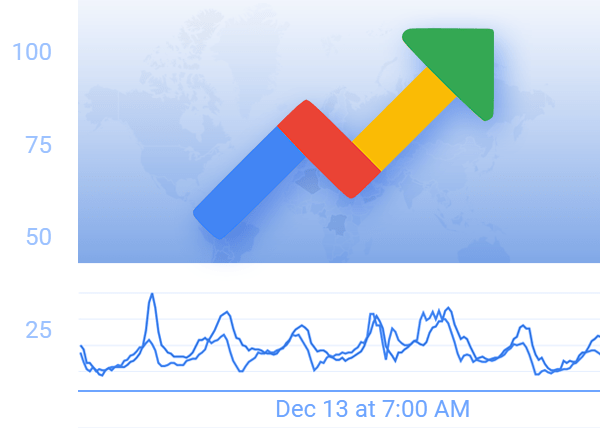Google Trends from A - Z
Born late, Google Trends has surpassed all of the keyword machines to become the most powerful tool for SEO.
Millions of site owners, serious marketers, entrepreneurs, online businessmen, etc. on this planet have been putting their trust in Google Trends to gain their competitive edge.
What is Google Trends? How does it work? How to make the most of it to accelerate your business?
Keep reading to find out the answer!

What is Google Trends?
Google Trends refers to a free tool developed by Google, aiming to provide insight into the popularity of certain search queries in Google Search and YouTube across different locations and languages.
The data is visualized under a graph style, letting you intuitively compare the search volume of multiple search terms over time. You can view if a trend is rising or declining.
Google Trends brief timeline:
The tool was originally brought to life in May 2006. However, its first launch wasn’t a hit since Google didn’t pay attention to updating Google Trends on a regular basis.
12 years later, the latest version of Google Trends was released, which was in May 2018.
- In May 2006 Google Trends was introduced.
- On August 5, 2008 Google launched Google Insights for Search.
- On September 27, 2012 Google merged Google Insights for Search into Google Trends with a new user interface.
How does Google Trends Work?
You can easily visit the tool to explore how it works. It shows you details on daily search trends, real-time search trends, year in search, and many others. Especially, you’re able to see a comparison of search terms in particular regions and time ranges.
Here is what we’ve got in the front-end when we compared “black widow” and “Spider-Man: Now Way Home.”
How about at the back-end?
To make comparisons between terms easier, Google Trends gathers all the search data from Google Searches then normalizes it based on the time and location of a query.
The following process will show you how:
- Google Trends will divide each data point according to the total searches of the geography and time range it represents to compare relative popularity.
- The resulting numbers are then scaled between 0 and 100 based on the ratio of a topic to all searches across all topics.

What Searches are Included in Google Trends?
Apart from reflecting the data people search on Google every day, the tool can also indicate irregular search activity, including automated searches or queries related to spam search results.
Following are some types of searches Google Trends does filter out:

Searches made by few people: Google Trends displays data for popular terms only. So, search terms with low volume appear as "0."

Duplicate searches: Google Trends removes repeated searches from the same person in a short period of time.

Special characters: Google Trends sorts out queries with apostrophes and other special characters.
9 Mind-blowing Tricks to Make the Most of Google Trends
There might be times you would love to expand your niche into other verticals. Rather than just selling only one particular product in your store, you plan to target other relevant product categories that your customers may also be fond of. At that point, check out Google Trends Related topics might be helpful.
For example, here is what we’ve got when looking for “hoodies”. So you can think of selling “sweatshirt” alongside “hoodies.”
Next, you may ponder: what name should you give your product categories to catch the trend? Which keywords to go after? How to optimize a blog post on the topic of a certain keyword?
This little trick will help you figure them out: take a quick look at the “Related queries” section next to the “Related topics” one.
So you can name your hoodie category as “mens hoodies” or “zip hoodies.” At the same time, write content targeting these keywords “ nike hoodies” or “black hoodies” on your blog. Smart, right?
Seasonal trends undoubtedly bring a great deal of revenue to your business. Throughout the year, there’ll always be peaks and falls that hugely affect your monthly sales. It’s obvious that there’ll be an outburst in sales during peak season. How about the dips? It’s a great time to start selling/promoting seasonal products.
Looking at the graph “Interest over time” will give you a clear picture of when you should promote your swimsuit products.
One of the best offers of Google Trends is how you can find niche topics by region. This proves handy as you can target an audience based on their country for advertising.
Let’s say you target the US audience. And surely that the prospects in each state will vary in wants and needs. Since you know the growing interest in particular regions, you’ll be able to decide promotion medium, i.e whether you promote it on Facebook or via Google Adwords.
Staying ahead of your rivals now becomes easier thanks to Google Trends Compares. It allows you to see how well they’re performing against your brand.
In case you spot any faster growth rate in the competitor sides compared to yours, you can get your hands on analyzing their marketing channels, then sketch out a strategy for improvement.
Improve your social media reach with Google Youtube. You can use this amazing feature to promote your older video content.
Google always loves repurposed and evergreen content and will likely reward you with a higher position for your videos.
It’s great that you can make use of Google Trends to pinpoint the best time to create Google Shopping ads.
Imagine you’re an accessory retailer trying to promote brand new socks in your store. And that’s how Google Trends’ Google Shopping feature tells you the best months for your ads.